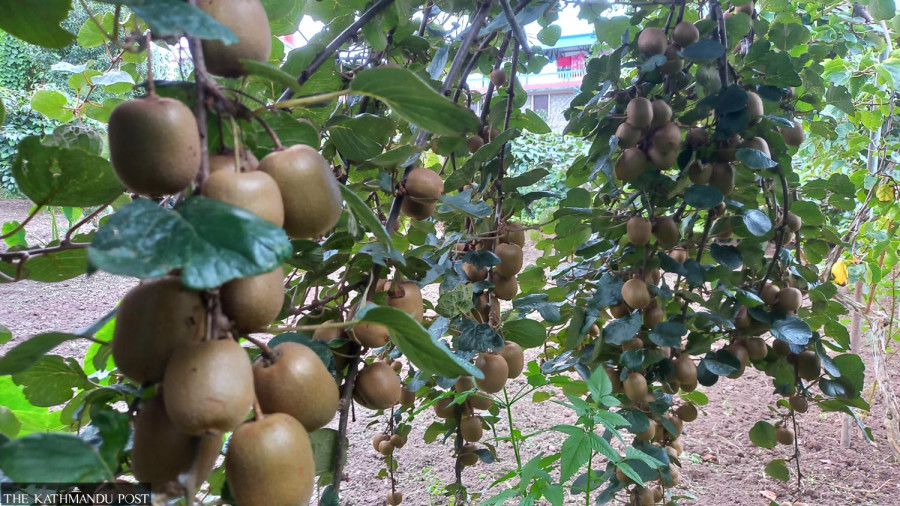Money
Kiwi farming blooms in Dolakha, but fruit finds no takers
This year’s bumper crop is good news for consumers. However, the price fails to cheer 3,000 kiwi growers in the mountain district.
Kedar Shiwakoti
Raju Thapa has a bountiful kiwi crop in his orchard. But he is worried because of the low prices he might get for his fruit this year.
The price has dropped to Rs100 per kg this year from Rs150 last year. Thapa has four tonnes of kiwi. In the crop’s initial years, after its introduction in Nepal nearly two decades ago, the fruit fetched as much as Rs1,000 per kg.
This year’s yield augurs well for consumers, but the inevitable price war has already triggered worries for around 3,000 kiwi growers in Dolakha, in the eastern mountain region.
Lower prices mean lower return for the growers. “The price is falling every year,” laments Thapa. And as competition hots up, kiwi growers are sending unripe fruit to the market. “It’s causing everyone trouble.”
Thapa owns Gairashowara Krishi Firm in Bhimeshwor municipality, which has 6,800 kiwi plants.
Thapa, who has been producing two varieties of kiwi—Hayward and Allison, has been exploring the market for the past two months.
Most farmers have started harvesting the fruit to manage their Dashain expenses. However, taking kiwis to the market before they ripen has created additional problems.
“Hayward and Alison kiwi fruit needs to be plucked in December and January but farmers have started sending it to market,” Thapa said.
The number of kiwi farmers in the district has grown, but the price is falling every year.
“I started kiwi farming hoping for good returns. But the market is saturated and price unpredictable.”
The kiwi varieties cultivated here are red and golden. The red fruit is priced comparatively higher. Red kiwi hit the market in September after it started maturing in July.
Lila Bahadur Subedi from Bhimeshwor municipality-3, who took red kiwis to the market last week, has a similar story to tell.
“The price of red kiwi was fine until last year,” he said. “This year, all of a sudden, it plunged to Rs200 per kg.”
Farmers saw the price drop by Rs100 per kg annually, Subedi said. Red kiwi sells for Rs200 to Rs300 per kg in the market.
Dolakha currently produces more than 8,000 tonnes of kiwi across six varieties, including Hayward, Allison, Monty and Bruno.
Gita Dahal of Bhimeshwor-6 planted 600 kiwi saplings five years ago. The plant has been giving fruits for two years now.
But she does not know where to sell. “As production has started, there is no assured market,” Dahal said.
If green kiwi had been graded, the price could have reached Rs150 per kg, Dahal said. Farmers are sending kiwi to the market two months before they are fully ripe, inviting, she added.
Kiwi farming is costly. Planting 50 plants costs Rs250,000.
Dahal said that unless the government starts branding Nepali kiwi and exporting it, the farmers will get no market. The domestic consumption of kiwi is low.
Kiwi weighing less than 80 grams is not considered of good quality.
Kiwi is rich in Vitamin C and Actinidin enzyme and can be cultivated at an altitude of 1,200–2,400m. The fruit is recognised for its healing properties, as it helps to treat and prevent several diseases, such as high blood pressure, malfunctioning digestive systems, and diabetes. So far, he has invested Rs2 million.
The government promoted Dolakha as a Kiwi zone, investing more than Rs80 million.
After the programme's success, the local level has shown no urgency to market and brand the fruits.
The deputy mayor, Kamala Basnet, said Bhimeshwor municipality has conducted skill development training to produce jam, jelly, juice, and other products from unsold kiwi.
“Farmers are selling kiwi through their network. The good ones are well-received in the market. We are encouraging farmers to produce other goods from non-graded kiwi,” Basnet said.
Though the Swiss first planted kiwi in Dolakha during the Lamosanghu-Jiri road construction, commercial farming in Nepal started in the Ilam and Kavre districts in 2007.




 22.65°C Kathmandu
22.65°C Kathmandu














